Test of the world's first window cleaning robot Windoro
Today we have a very interesting product - a window cleaning robot. Produced in Korea. Although it appeared back in 2010, the robot hit Russia just a few weeks ago. Initially, the manufacturer Ilshim Global was engaged in the manufacture of microfiber fabrics for domestic and industrial purposes. Apparently, in the wake of innovations and new technologies, the Koreans decided to present the world with a new type of devices and, together with the Institute of Robotics, released the window cleaner Robot Windoro. By the way, we already have the second modification of the device. It increases the operating time (and hence the cleaning area) and reduces the charging time due to the use of a lithium-polymer battery, instead of a lithium-ion battery in the first modification. How well Windoro cleans windows, what structural elements it consists of and whether there are other analogues on the market, we will discuss in detail in this article.
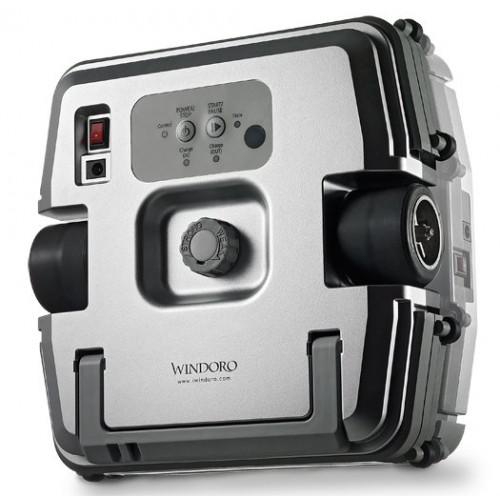
To date, the market has two robots for cleaning windows, each of them has its own principle. Korean Ilshim Global’s Windoro has two modules: one used for navigation, the other for cleaning. Modules are mounted on both sides of the glass and held by the use of permanent magnets. This means that even if the robot has a rechargeable battery, it will not fall, and will also continue to stay on the window.
')
 The first module is the “brains” for navigating the device along the glass surface. It does not clean, only calculates the size of the glass and determines the route. Windoro first sizes the window. To do this, it travels horizontally and vertically from the frame to the frame and rests against the edge of the window with a bumper. Next, the robot performs cleaning, moving along the snake, that is, the movement is consistent, not chaotic. The second module is cleaning. There are four rotating discs on it, to which microfiber pads are attached to the velcro. In the center is a hole for spraying liquid. Also at the edges there are scrapers made of cloth for cleaning the edges. The cleaning module has no wheels for movement, it moves only due to the magnetic field behind the navigation module.
The first module is the “brains” for navigating the device along the glass surface. It does not clean, only calculates the size of the glass and determines the route. Windoro first sizes the window. To do this, it travels horizontally and vertically from the frame to the frame and rests against the edge of the window with a bumper. Next, the robot performs cleaning, moving along the snake, that is, the movement is consistent, not chaotic. The second module is cleaning. There are four rotating discs on it, to which microfiber pads are attached to the velcro. In the center is a hole for spraying liquid. Also at the edges there are scrapers made of cloth for cleaning the edges. The cleaning module has no wheels for movement, it moves only due to the magnetic field behind the navigation module.
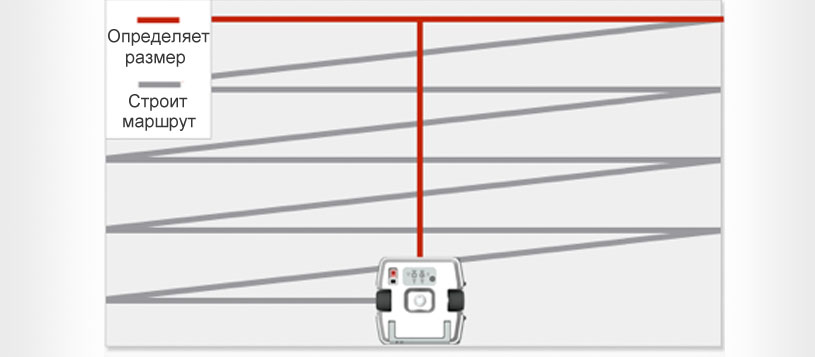
In the video below you can more thoroughly understand the principle of operation of Windoro.
As we have said, there is another robot for washing windows. He is not represented in Russia, but he should also be mentioned. The model is called Winbot from the Chinese company Ecovacs. Initially, a prototype of Winbot 5 was demonstrated, which was also fastened on both sides with magnets, but when Ilshim Global clearly indicated to the Chinese about patent infringement, the latter, without hesitation, released Winbot 7 with a vacuum principle. True, the device entered the market only in 2013. The principle of operation of Winbot 7 is slightly different, it has only one module, which is sucked to the glass by a vacuum sucker.
In this original video about a product with a Chinese girl who has been tormented by a grueling washing of the windows of windows, you can visually evaluate the principle of work.
At hand we do not have this device, so the real work and the quality of cleaning can be estimated by third-party rollers.
Winbot also determines the size of the glass and returns to the starting point after the end of the cleaning cycle. Only WInbot does not actually wash the glass, but rubs it. In essence, this is a glass floor polisher in which there is not even a washing liquid dispenser and rotating cleaning elements. WIndoro, in turn, on the contrary, sprays liquid and cleans the surface with the help of rotating napkins.
If we highlight the main pros and cons of devices, we get the following comparison:
On the last point is to make a reservation. For Windoro, you can use the auxiliary mount. One of the modules clings to it, on the reverse side of the glass we catch another module and release the outer part of the glass from fastening. That is, you still need access to the back of the window, but there is no need for partner assistance. Accessory is purchased separately.
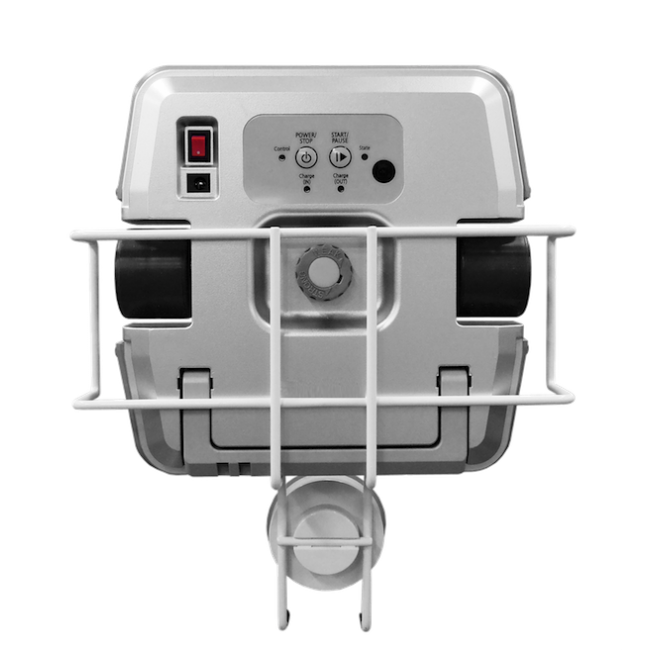
Thus, we get about the same story as with floor cleaning robots: iRobot Scooba and Mint. The first one really washes, cleans, and scrubs dirt, the second one — wipes it with a damp cloth. So here: Windoro mechanically removes dirt from the surface, while Winbot simply rubs the surface of the glass. A simple wipe is more suitable for home cleaning, washing mirrors.
Windoro is of two types: for cleaning windows with the distance between the panes on the passport from 5 to 15 mm and from 16 to 28 mm. So far, only the second type is being supplied to Russia due to its greater popularity. Available in three colors: silver, red and yellow. In fact, the robot can clean windows with a distance of up to 35 mm between the panes, but at the same time it will leave a few centimeters on top of the uncleaned space, since without the necessary force of attraction it will move down a little at the beginning of the cleaning cycle. But more on that below in our test video.
There are now many different plastic window profiles on the market. The distance between the panes often varies. Even if the width of the frame of the glass unit is 56 mm, then the distance between the panes can be either less than 30 mm or all 35 mm. Often, in windows with a frame width of 70 mm, the distance between the panes (including the thickness of the panes itself) is 35 mm.
Also semicircular frames are not suitable for cleaning. In view of the straight-line route of the robot, there will be uncleared areas around the edges.
In all other cases, the robot covers 100% of the glass area.

It is advisable to run Windoro not on completely dirty windows and with clean wheels, because due to wheel slip (in particular, at distances over 30 mm), the robot can crawl, or with a noticeable effort to try to overcome the area. Although if the window is in a hard-to-reach place, then it is possible to launch a dirty one. Just a robot will need 2-3 cleaning cycles to completely clean the window. After cleaning, it is necessary that the glass is dry before the next cleaning cycle, or before cleaning the other side of the window. Again, all because on the wet surface of the wheel can slip. In the above photo, the robot cleaned the old Soviet frame with a distance between the panes of 36 mm.
It seems like all sorts of restrictions, but in fact, if all the requirements for the glasses are met, there is nothing complicated. On one charge, the Windoro lithium-polymer battery can remove up to 15 square meters.
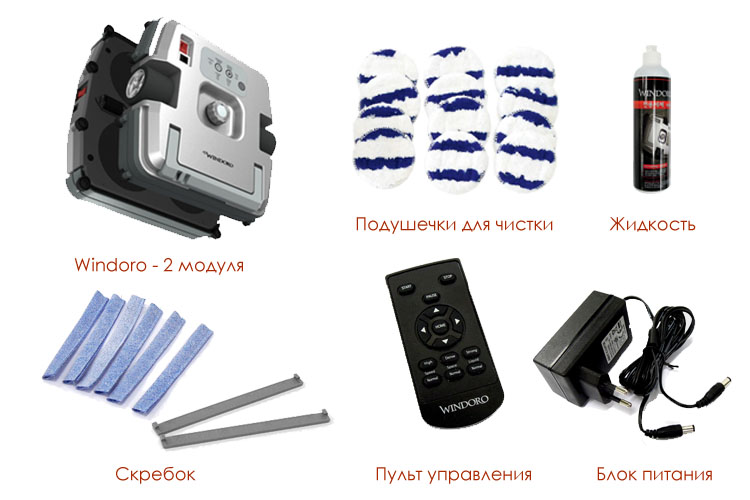
The robot comes in a small package. Included you will find two modules (navigation and cleaning), a power supply unit with two outputs (for simultaneous charging of both modules), a proprietary window cleaning fluid, an IR remote control, 12 microfiber cloths and 6 side scrapers. Korean quality workmanship and plastic causes no complaints. Initially, the modules are located in the box so that they are not magnetised to each other. During the operation of the Windoro, it is not necessary to press both parts together with the inner side. If, however, this happened, it is necessary to weaken the magnetic field with the help of the regulator (by increasing the distance between the magnets) and, twisting it to the side and towards itself, detach the modules. A fragile girl, this procedure may not be able to.
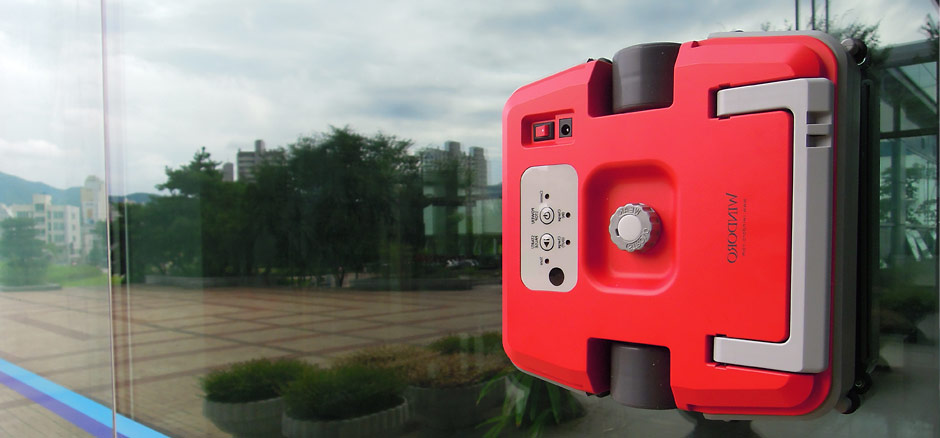
The navigation module is characterized by the presence of control buttons and driving wheels. Also on the navigation module is a mechanism for adjusting the force of attraction of the magnets. It is elementary: the mechanical rotation of the handle allows you to change the distance between the magnets. It is worth noting that there is an indicator right there that tells you whether the robot can move through this thickness between the panes or not. If the indicator is lit in red, the robot realizes that the force of attraction of the magnets may not be enough, and it will not budge. If, after adjustment by the knob, the indicator lights up green, the robot is ready for cleaning.
 On the cleaning module there is a valve for filling the container with cleaning agent. Capacity has a volume of 40 ml. This is enough for a full hour and a half cleaning cycle or 15 square meters. The manufacturer, of course, recommends using the original tool, which, taking into account the low consumption, will be enough for cleaning 300 - 350 square meters. But you can also use the device without liquid, just with water. We have repeatedly launched Windoro with the usual window cleaner, and there were no problems, and they cannot be. It is recommended to use a colored liquid to monitor its level in the tank through translucent plastic.
On the cleaning module there is a valve for filling the container with cleaning agent. Capacity has a volume of 40 ml. This is enough for a full hour and a half cleaning cycle or 15 square meters. The manufacturer, of course, recommends using the original tool, which, taking into account the low consumption, will be enough for cleaning 300 - 350 square meters. But you can also use the device without liquid, just with water. We have repeatedly launched Windoro with the usual window cleaner, and there were no problems, and they cannot be. It is recommended to use a colored liquid to monitor its level in the tank through translucent plastic.
Using the remote control, you can set the direction of movement of Windoro, start / stop the cleaning cycle, change the speed of movement, set the quality of cleaning, the volume of sprayed liquid. Only the navigation module responds to the console, there is no IR receiver on the cleaning module
There are three colors to choose from. On the storefront, a red or yellow Windoro will uniquely collect passing onlookers.
Habr's readers are advanced people. They are not interested in a simple description, so especially for Habr, we disassembled both Windoro modules to look at all the microcontrollers, electric drives, sensors with our own eyes.
The first to get to the operating table was the navigation module. Turn off the bolts on the bottom of the module and see the brains located on the main chip. It also has buttons, power, IR receiver (to the right of the buttons). Mechanical bumper sensors are installed in the corners of the case. Two main electric drives - in the center. The battery capacity of 2200 MAh simply lies on the magnets and holds so tightly that without effort it does not budge. Magnetic disks attract everything, including unscrewed bolts.

There is nothing more to unscrew, except for the main board from the case.
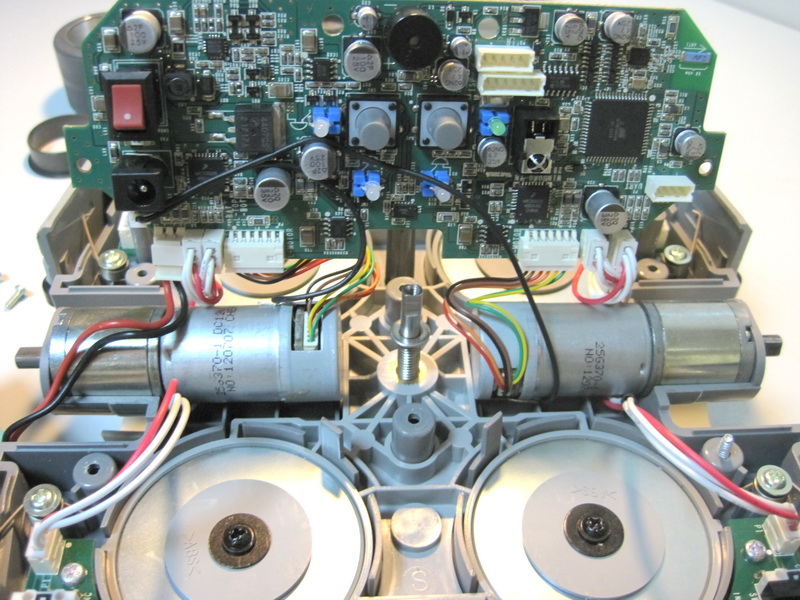
The diagram below shows the designations of the main elements of Windoro design:

1 - bumper sensor
2 - Fee
3 - Adjust the force of attraction of the magnets
4 - Battery
5 - Power wheels
6 - Magnet
7 - Spring bumper
Now look inside the washing module. After simple manipulations with a screwdriver, we see the following picture:
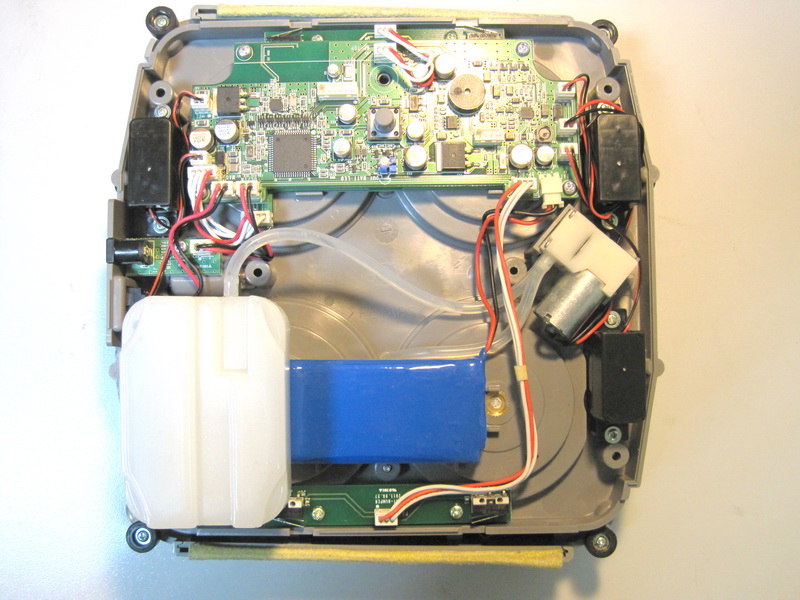
Next to the liquid tank is a mini-pump for spraying detergent on the glass surface. The battery is attached by glue to the device. Black square modules - electric drives for magnets. Below is a schematic representation of the elements.
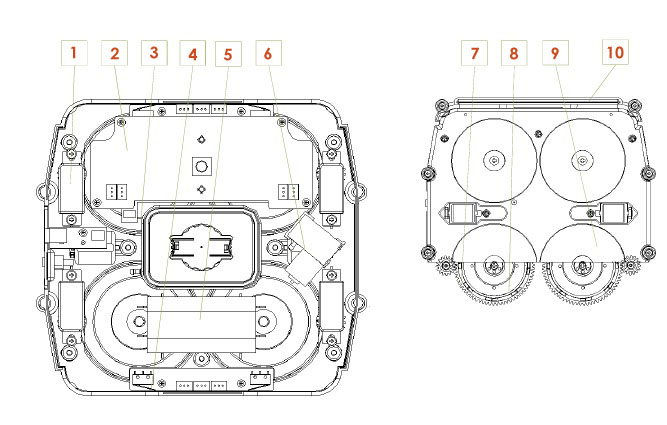
1 - Electric drive
2 - Fee
3 - Sensor magnet force
4 - bumper sensor
5 - Battery
6 - Mini pump
7 - Gear
8 - Magnet
9 - Microfiber
10 - Side scraper

A pressurized pump sprays liquid onto the glass surface through a narrow nozzle.

Four electric drives drive the drive through gears.
In general, we got acquainted with the device of the robot, it's time to go to practical tests.
We decided to test the Windoro on a frame with a distance of 30 mm between the panes. This is more than stated on the passport 2 mm. For clarity, we applied paint from a bookstore and launched the device twice.
The test results showed that about 95% of the window the robot laundered almost perfectly. Good reusable microfiber pads do their job. By the way, they are made of two types of material, the insertion of blue is noticeably tougher in structure than white. Thus, Windoro cleans well and old dirt.
Due to the greater distance between the panes than is required on the passport, the robot left about 3-4 cm in the upper part of the window. As we have already mentioned, this happens because the force of attraction between the modules weakens as the distance increases and the robot finds it harder to hold onto the window, it moves down. Further, the robot adjusts its route, rising slightly upwards with horizontal movement, but does not affect the upper part of the glass.
As for the edges of the windows, Windoro almost completely cleans them with side scrapers, but since they do not rotate, unlike microfiber, there can be slightly noticeable marks on the window when viewed at an angle. Such dusty windows that have not been wiped for years are recommended to be washed twice. Two minutes later, after the clean side of the window had dried, we swapped the modules for cleaning the inner surface. It is also recommended to clean the wheels of the robot, as if they accumulate dust and dirt, they will begin to slip.
If the distance between the panes is as stated in the instructions, then Windoro completely gets to the top of the window and cleans along the upper frame.
With visual results of the tests you can find in the video below.
The window cleaner robot is a very interesting product, which at the same time requires the right operating conditions. In suitable conditions (the width between the panes, taking into account the thickness of the panes themselves, should not exceed 30 mm and be less than 15 mm) Windoro copes very well with cleaning the window, leaving only a faint trace at the edges. Of course, the robot is not a device of paramount importance, but with the availability of funds it will help to safely wash the windows in high-rise apartments and in the country. Although at the time of this writing, the season of such devices is coming to an end, Windoro can also be used indoors, or become an original gift. As often happens with such gadgets, at first you think that this is just a toy, but after a couple of weeks of using “you get used to good.”
The recommended price for the device is set by the official representative of Windoro in Russia and amounts to 19,800 rubles. The choice to purchase such a gadget or use the services of cleaning companies is always yours.

Principle of operation
To date, the market has two robots for cleaning windows, each of them has its own principle. Korean Ilshim Global’s Windoro has two modules: one used for navigation, the other for cleaning. Modules are mounted on both sides of the glass and held by the use of permanent magnets. This means that even if the robot has a rechargeable battery, it will not fall, and will also continue to stay on the window.
')
 The first module is the “brains” for navigating the device along the glass surface. It does not clean, only calculates the size of the glass and determines the route. Windoro first sizes the window. To do this, it travels horizontally and vertically from the frame to the frame and rests against the edge of the window with a bumper. Next, the robot performs cleaning, moving along the snake, that is, the movement is consistent, not chaotic. The second module is cleaning. There are four rotating discs on it, to which microfiber pads are attached to the velcro. In the center is a hole for spraying liquid. Also at the edges there are scrapers made of cloth for cleaning the edges. The cleaning module has no wheels for movement, it moves only due to the magnetic field behind the navigation module.
The first module is the “brains” for navigating the device along the glass surface. It does not clean, only calculates the size of the glass and determines the route. Windoro first sizes the window. To do this, it travels horizontally and vertically from the frame to the frame and rests against the edge of the window with a bumper. Next, the robot performs cleaning, moving along the snake, that is, the movement is consistent, not chaotic. The second module is cleaning. There are four rotating discs on it, to which microfiber pads are attached to the velcro. In the center is a hole for spraying liquid. Also at the edges there are scrapers made of cloth for cleaning the edges. The cleaning module has no wheels for movement, it moves only due to the magnetic field behind the navigation module.
In the video below you can more thoroughly understand the principle of operation of Windoro.
As we have said, there is another robot for washing windows. He is not represented in Russia, but he should also be mentioned. The model is called Winbot from the Chinese company Ecovacs. Initially, a prototype of Winbot 5 was demonstrated, which was also fastened on both sides with magnets, but when Ilshim Global clearly indicated to the Chinese about patent infringement, the latter, without hesitation, released Winbot 7 with a vacuum principle. True, the device entered the market only in 2013. The principle of operation of Winbot 7 is slightly different, it has only one module, which is sucked to the glass by a vacuum sucker.
In this original video about a product with a Chinese girl who has been tormented by a grueling washing of the windows of windows, you can visually evaluate the principle of work.
At hand we do not have this device, so the real work and the quality of cleaning can be estimated by third-party rollers.
Winbot also determines the size of the glass and returns to the starting point after the end of the cleaning cycle. Only WInbot does not actually wash the glass, but rubs it. In essence, this is a glass floor polisher in which there is not even a washing liquid dispenser and rotating cleaning elements. WIndoro, in turn, on the contrary, sprays liquid and cleans the surface with the help of rotating napkins.
If we highlight the main pros and cons of devices, we get the following comparison:
| Windoro | Winbot |
| Two modules firmly hold on the window due to the permanent magnet. | One module is held by a vacuum sucker. It may fall, so you need to use a suction cup to prevent damage to the device. |
| There is a detergent dispenser and microfiber rotating pads. | Detergent can only be moistened with a cloth by hand; there are no rotating parts for effective dirt cleaning. |
| Powered by lithium-polymer batteries. Continuous operation time up to 1.5 hours. | It works only with mains power. If there is no mains supply, the robot will last for some time on the built-in lithium-ion battery. The size of the cleaning area is limited by the length of the wire. |
| It works only on windows with a distance between the panes: from 5 to 15 mm and another modification from 16 to 28 mm. | Works at any distances between glasses. |
| Washes on one side only. May clean up heavily polluted glass, but the first cleaning cycle may be of poor quality. It is recommended to run 1-2 more times. | Also washes only one surface. Cannot start work on contaminated glass, as the tracks will slip. |
| Completely covers the entire surface of the glass, but the edges are cleaned only with a scraper, and not with rotating pads. | Leaves more uncleared areas around the edges and takes more time to clean. |
| It is necessary that the window be opened, otherwise the robot from two sides at the same time will not work. * | No need to open the window. |
On the last point is to make a reservation. For Windoro, you can use the auxiliary mount. One of the modules clings to it, on the reverse side of the glass we catch another module and release the outer part of the glass from fastening. That is, you still need access to the back of the window, but there is no need for partner assistance. Accessory is purchased separately.

Thus, we get about the same story as with floor cleaning robots: iRobot Scooba and Mint. The first one really washes, cleans, and scrubs dirt, the second one — wipes it with a damp cloth. So here: Windoro mechanically removes dirt from the surface, while Winbot simply rubs the surface of the glass. A simple wipe is more suitable for home cleaning, washing mirrors.
Window type
Windoro is of two types: for cleaning windows with the distance between the panes on the passport from 5 to 15 mm and from 16 to 28 mm. So far, only the second type is being supplied to Russia due to its greater popularity. Available in three colors: silver, red and yellow. In fact, the robot can clean windows with a distance of up to 35 mm between the panes, but at the same time it will leave a few centimeters on top of the uncleaned space, since without the necessary force of attraction it will move down a little at the beginning of the cleaning cycle. But more on that below in our test video.
There are now many different plastic window profiles on the market. The distance between the panes often varies. Even if the width of the frame of the glass unit is 56 mm, then the distance between the panes can be either less than 30 mm or all 35 mm. Often, in windows with a frame width of 70 mm, the distance between the panes (including the thickness of the panes itself) is 35 mm.
Also semicircular frames are not suitable for cleaning. In view of the straight-line route of the robot, there will be uncleared areas around the edges.
In all other cases, the robot covers 100% of the glass area.

It is advisable to run Windoro not on completely dirty windows and with clean wheels, because due to wheel slip (in particular, at distances over 30 mm), the robot can crawl, or with a noticeable effort to try to overcome the area. Although if the window is in a hard-to-reach place, then it is possible to launch a dirty one. Just a robot will need 2-3 cleaning cycles to completely clean the window. After cleaning, it is necessary that the glass is dry before the next cleaning cycle, or before cleaning the other side of the window. Again, all because on the wet surface of the wheel can slip. In the above photo, the robot cleaned the old Soviet frame with a distance between the panes of 36 mm.
It seems like all sorts of restrictions, but in fact, if all the requirements for the glasses are met, there is nothing complicated. On one charge, the Windoro lithium-polymer battery can remove up to 15 square meters.
Appearance and equipment Windoro

The robot comes in a small package. Included you will find two modules (navigation and cleaning), a power supply unit with two outputs (for simultaneous charging of both modules), a proprietary window cleaning fluid, an IR remote control, 12 microfiber cloths and 6 side scrapers. Korean quality workmanship and plastic causes no complaints. Initially, the modules are located in the box so that they are not magnetised to each other. During the operation of the Windoro, it is not necessary to press both parts together with the inner side. If, however, this happened, it is necessary to weaken the magnetic field with the help of the regulator (by increasing the distance between the magnets) and, twisting it to the side and towards itself, detach the modules. A fragile girl, this procedure may not be able to.

The navigation module is characterized by the presence of control buttons and driving wheels. Also on the navigation module is a mechanism for adjusting the force of attraction of the magnets. It is elementary: the mechanical rotation of the handle allows you to change the distance between the magnets. It is worth noting that there is an indicator right there that tells you whether the robot can move through this thickness between the panes or not. If the indicator is lit in red, the robot realizes that the force of attraction of the magnets may not be enough, and it will not budge. If, after adjustment by the knob, the indicator lights up green, the robot is ready for cleaning.
 On the cleaning module there is a valve for filling the container with cleaning agent. Capacity has a volume of 40 ml. This is enough for a full hour and a half cleaning cycle or 15 square meters. The manufacturer, of course, recommends using the original tool, which, taking into account the low consumption, will be enough for cleaning 300 - 350 square meters. But you can also use the device without liquid, just with water. We have repeatedly launched Windoro with the usual window cleaner, and there were no problems, and they cannot be. It is recommended to use a colored liquid to monitor its level in the tank through translucent plastic.
On the cleaning module there is a valve for filling the container with cleaning agent. Capacity has a volume of 40 ml. This is enough for a full hour and a half cleaning cycle or 15 square meters. The manufacturer, of course, recommends using the original tool, which, taking into account the low consumption, will be enough for cleaning 300 - 350 square meters. But you can also use the device without liquid, just with water. We have repeatedly launched Windoro with the usual window cleaner, and there were no problems, and they cannot be. It is recommended to use a colored liquid to monitor its level in the tank through translucent plastic.Using the remote control, you can set the direction of movement of Windoro, start / stop the cleaning cycle, change the speed of movement, set the quality of cleaning, the volume of sprayed liquid. Only the navigation module responds to the console, there is no IR receiver on the cleaning module
There are three colors to choose from. On the storefront, a red or yellow Windoro will uniquely collect passing onlookers.
Disassemble windoro
Habr's readers are advanced people. They are not interested in a simple description, so especially for Habr, we disassembled both Windoro modules to look at all the microcontrollers, electric drives, sensors with our own eyes.
The first to get to the operating table was the navigation module. Turn off the bolts on the bottom of the module and see the brains located on the main chip. It also has buttons, power, IR receiver (to the right of the buttons). Mechanical bumper sensors are installed in the corners of the case. Two main electric drives - in the center. The battery capacity of 2200 MAh simply lies on the magnets and holds so tightly that without effort it does not budge. Magnetic disks attract everything, including unscrewed bolts.

There is nothing more to unscrew, except for the main board from the case.

The diagram below shows the designations of the main elements of Windoro design:

1 - bumper sensor
2 - Fee
3 - Adjust the force of attraction of the magnets
4 - Battery
5 - Power wheels
6 - Magnet
7 - Spring bumper
Now look inside the washing module. After simple manipulations with a screwdriver, we see the following picture:

Next to the liquid tank is a mini-pump for spraying detergent on the glass surface. The battery is attached by glue to the device. Black square modules - electric drives for magnets. Below is a schematic representation of the elements.

1 - Electric drive
2 - Fee
3 - Sensor magnet force
4 - bumper sensor
5 - Battery
6 - Mini pump
7 - Gear
8 - Magnet
9 - Microfiber
10 - Side scraper

A pressurized pump sprays liquid onto the glass surface through a narrow nozzle.

Four electric drives drive the drive through gears.
In general, we got acquainted with the device of the robot, it's time to go to practical tests.
Test results
We decided to test the Windoro on a frame with a distance of 30 mm between the panes. This is more than stated on the passport 2 mm. For clarity, we applied paint from a bookstore and launched the device twice.
The test results showed that about 95% of the window the robot laundered almost perfectly. Good reusable microfiber pads do their job. By the way, they are made of two types of material, the insertion of blue is noticeably tougher in structure than white. Thus, Windoro cleans well and old dirt.
Due to the greater distance between the panes than is required on the passport, the robot left about 3-4 cm in the upper part of the window. As we have already mentioned, this happens because the force of attraction between the modules weakens as the distance increases and the robot finds it harder to hold onto the window, it moves down. Further, the robot adjusts its route, rising slightly upwards with horizontal movement, but does not affect the upper part of the glass.
As for the edges of the windows, Windoro almost completely cleans them with side scrapers, but since they do not rotate, unlike microfiber, there can be slightly noticeable marks on the window when viewed at an angle. Such dusty windows that have not been wiped for years are recommended to be washed twice. Two minutes later, after the clean side of the window had dried, we swapped the modules for cleaning the inner surface. It is also recommended to clean the wheels of the robot, as if they accumulate dust and dirt, they will begin to slip.
If the distance between the panes is as stated in the instructions, then Windoro completely gets to the top of the window and cleans along the upper frame.
With visual results of the tests you can find in the video below.
findings
The window cleaner robot is a very interesting product, which at the same time requires the right operating conditions. In suitable conditions (the width between the panes, taking into account the thickness of the panes themselves, should not exceed 30 mm and be less than 15 mm) Windoro copes very well with cleaning the window, leaving only a faint trace at the edges. Of course, the robot is not a device of paramount importance, but with the availability of funds it will help to safely wash the windows in high-rise apartments and in the country. Although at the time of this writing, the season of such devices is coming to an end, Windoro can also be used indoors, or become an original gift. As often happens with such gadgets, at first you think that this is just a toy, but after a couple of weeks of using “you get used to good.”
The recommended price for the device is set by the official representative of Windoro in Russia and amounts to 19,800 rubles. The choice to purchase such a gadget or use the services of cleaning companies is always yours.
Source: https://habr.com/ru/post/197960/
All Articles